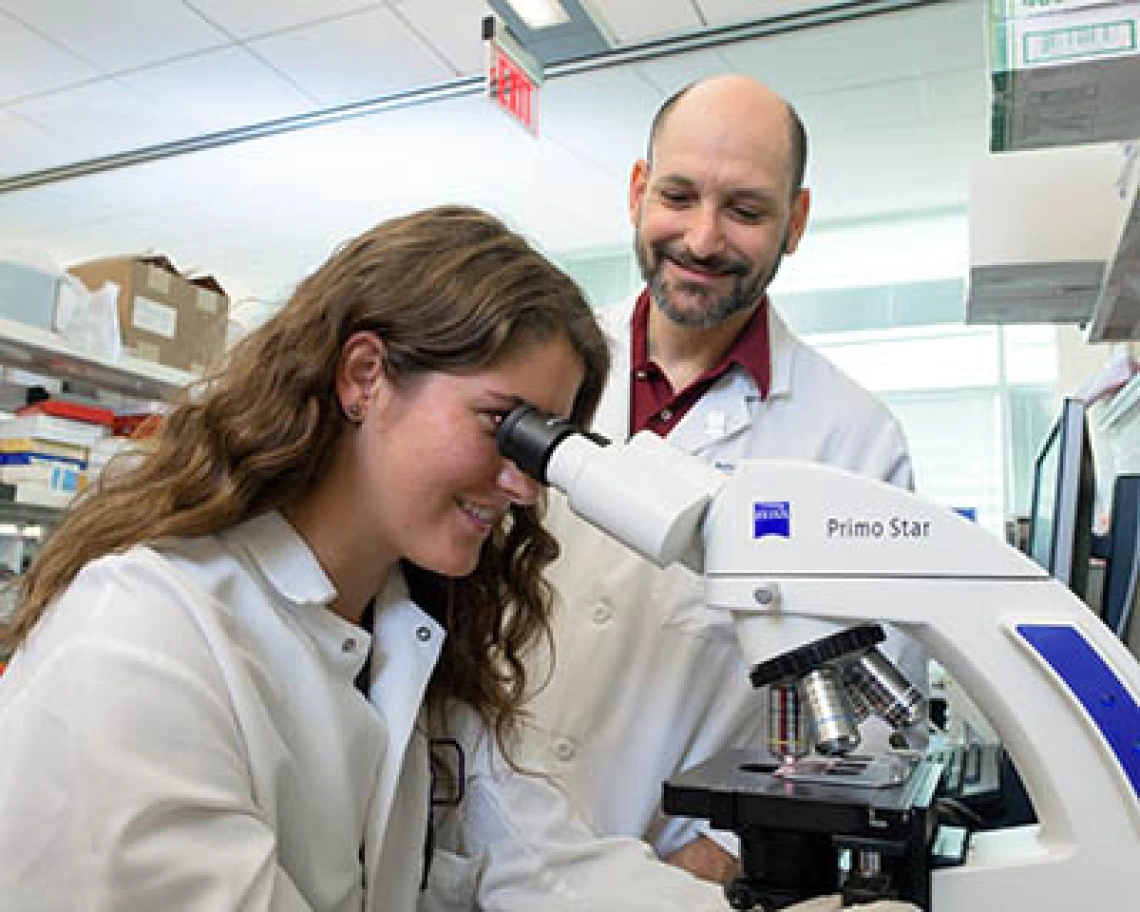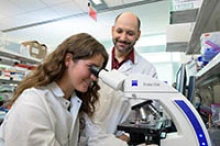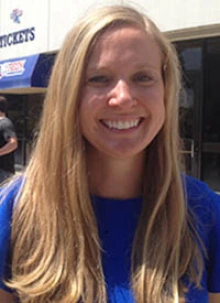UArizona Researchers Team Up to Change Outcomes in Traumatic Brain Injuries
University of Arizona and Louisiana Tech scientists have collaborated to improve memory and emotional problems caused by blunt head trauma — their findings appear in Scientific Reports.

PHOENIX — Researchers at the University of Arizona Health Sciences and Louisiana Tech University have advanced evidence for a treatment option that could prevent memory deficits and emotional problems in patients suffering from axonal injury caused by traumatic brain injuries (TBIs).
In the brain, axons are processes that connect a neuron to other neurons – connections that are crucial for every thought and feeling we experience. When an axon is damaged, it cannot relay these messages to important processing centers elsewhere in the brain or body.

Drs. Rachel Rowe and Jonathan Lifshitz (right) examine specimens in the lab.
Using a novel combination of high-resolution imaging and a gradient index (GRIN) lens implanted in the brain of mice, researchers documented axonal injury and the recovery process after a blunt injury to the brain. GRIN lenses are microscopic glass lenses that allow scientists to focus closely on the cells for excellent image quality. These lenses are smaller than Lincoln’s nose on a U.S. penny and were adopted by a handful of biologists to better study the brain.
Tracking the time in which axons become affected, they employed a clinically approved drug, minocycline, to reduce inflammation, which slowed axon injury, recovered axons from injury and preserved function. They tested the drug’s effectiveness for immediate use within 45 minutes of the incident, compared to delayed use at three days post-injury – both time points showed positive effects. These findings were published May 8 in Scientific Reports.
Jonathan Lifshitz, PhD, and Rachel Rowe, PhD, from the Translational Neurotrauma Research Program at the University of Arizona College of Medicine – Phoenix, collaborated with Chelsea Pernici, PhD, and Teresa Murray, PhD, from the Center for Biomedical Engineering and Rehabilitation Sciences at Louisiana Tech University. The study was led by Drs. Pernici and Murray, who used a new imaging technology to show how diseases and injuries affect the brain over time and how medicines could reduce brain damage.
Tracking the time in which axons become affected, they employed a clinically approved drug, minocycline, to reduce inflammation, which slowed axon injury, recovered axons from injury and preserved function. They tested the drug’s effectiveness for immediate use within 45 minutes of the incident, compared to delayed use at three days post-injury – both time points showed positive effects. These findings were published May 8 in Scientific Reports.

Teresa Murray, PhD
“The fine communication elements of neurons – axons – are torn, ruptured and damaged, which contributes to a multitude of clinical symptoms,” said Dr. Lifshitz, director of the Translational Neurotrauma Research Program. “To date, these processes have been inferred from fixed microscopic sections, clinical imaging and cells in culture. No one has observed an axon prior to injury, the consequence of injury and the outcome. Here, we show that axons do sustain injury and either can recover or become truncated.”
Their research showed that some damaged axons continue to degrade and some even break apart after days or weeks, which is a permanent lost connection to other neurons. Furthermore, they saw that some previously healthy axons became damaged over time because of the inflammation caused by the TBI.
With treatment, a much larger percentage of damaged axons healed, compared to those without treatment, their research showed. As predicted, the immediate treatment resulted in the fewest number of damaged axons. Surprisingly, delayed treatment resulted in the highest percentage of axons that healed from their injury. For both treatments (immediate and delayed), damage did not spread as much to undamaged axons.

Chelsea Pernici
“Most brain injuries cause damage to just a few axons,” said Dr. Murray, a Louisiana Tech associate professor. “These few axons cannot be seen on MRIs and CT scans. So, most TBI patients are sent home with the hope that they will get better over time. However, even a few damaged axons can disrupt communication in the brain and affect neurological function.”
Dr. Murray developed an improved GRIN lens system to see more details of brain cells. Her team also designed 3D-printed hardware to help them find the exact same cells for each imaging session. This allowed the team to find and evaluate the same injured axons over several weeks post-injury.
“The novel fluorescence imaging method using GRIN lenses allows researchers to study brain cells in both time and space, offering a unique opportunity to better understand the effect of drugs on brain structure over time,” said Dr. Pernici, a doctoral student. “It’s exciting to see that although axons become damaged after TBI, the injury can resolve and, with this method, we can better understand that timescale.”
No drug is on the market that is clinically used to prevent axon injury. The current results add evidence to support continued investigation of minocycline for TBI treatment.
“This study provides hope that we can use minocycline effectively if the drug can be taken early in the process and not given long-term. This could help reduce the inflammation, and thus some of the permanent damage caused by brain injury,” Dr. Murray said.
The team plans to continue its research by pairing minocycline with another drug to see if this early damage can be reduced further. If successful, this could greatly lessen the chances of memory loss and emotional problems for people suffering a TBI, Dr. Murray added.
# # #
NOTE: Photos available upon request.
About the UArizona College of Medicine – Phoenix
Founded in 2007, the University of Arizona College of Medicine – Phoenix inspires and trains exemplary physicians, scientists and leaders to optimize health and health care in Arizona and beyond. By cultivating collaborative research locally and globally, the college accelerates discovery in a number of critical areas — including cancer, stroke, traumatic brain injury and cardiovascular disease. Championed as a student-centric campus, the college has graduated 500 physicians, all of whom received exceptional training from nine clinical partners and 1,800 diverse faculty members. As the anchor to the Phoenix Biomedical Campus, which is projected to have an economic impact of $3.1 billion by 2025, the college prides itself on engaging with the community, fostering education, inclusion, access and advocacy. For more information, please visit phoenixmed.arizona.edu (Follow us: Facebook | Twitter | YouTube | LinkedIn | Instagram).
About the University of Arizona Health Sciences
The University of Arizona Health Sciences is the statewide leader in biomedical research and health professions training. UArizona Health Sciences includes the Colleges of Medicine (Tucson and Phoenix), Nursing, Pharmacy, and the Mel and Enid Zuckerman College of Public Health, with main campus locations in Tucson and the Phoenix Biomedical Campus in downtown Phoenix. From these vantage points, Health Sciences reaches across the state of Arizona, the greater Southwest and around the world to provide next-generation education, research and outreach. A major economic engine, Health Sciences employs nearly 5,000 people, has approximately 4,000 students and 900 faculty members, and garners $200 million in research grants and contracts annually. For more information: uahs.arizona.edu (Follow us: Facebook | Twitter | YouTube | LinkedIn | Instagram).

